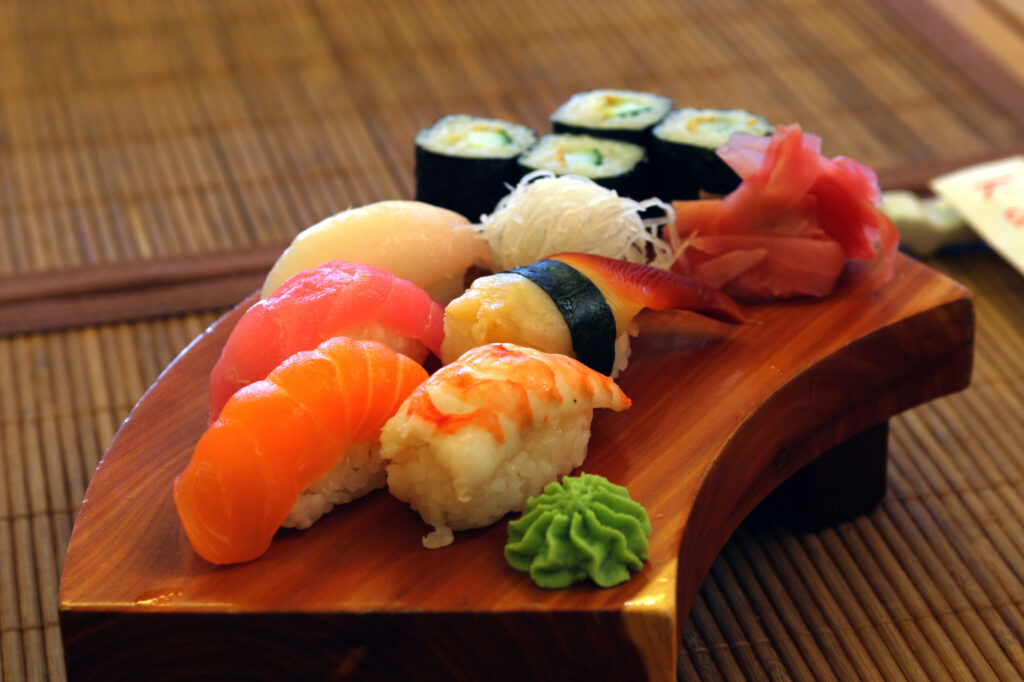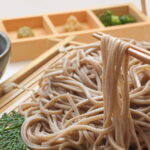Food is one of the best parts about travelling. No matter where you go, you’re bound to stumble across a dish that’s not available back home. But not everyone gets to partake in these once-in-a-lifetime dining experiences.
For people with gluten sensitivities, the excitement of discovering new food can be quickly replaced with disappointment as they realize they can’t eat it. Such is the case in Western culture, where everything from Southern comfort food to classic Italian is packed with gluten. That won’t be a problem when you visit Japan, though!
Unlike many Western cultures, Japanese cuisine offers a rich variety of dishes that are naturally made without gluten. People with gluten sensitivities are free to enjoy rice, sushi, noodles and more. And, even if a dish contains gluten, it’s easy enough to find substitutes without altering the flavor.
If you’re someone suffering from Celiac Disease or have a sensitivity that prevents you from enjoying foods with gluten in them, traveling to Japan will be a welcome reprieve. Keep reading to discover Japan’s most popular gluten-free cuisine and how to stay within your dietary restrictions, without compromising your culinary experience.

First, what is gluten?
Gluten is a type of protein found in several grains. The most common grains include wheat, barley, rye and triticale, which is a cross between wheat and rye. Oats are naturally gluten free, although some oat products may contain cross contamination if the oats are grown next to other grain crops or share machinery in the manufacturing process.
Gluten is often found in processed food because it acts as a binding agent that holds ingredients together. Manufacturers will extract the protein from grain and use it to help processed food retain its shape. Since gluten naturally occurs in grains, it’s usually present in grain-based products such as bread, baked goods, pasta, beer and soy sauce.
As you might’ve guessed, soy sauce is a staple in Japanese cuisine. Soy sauce is considered a gluten product because it’s made with wheat flour. So many Japanese dishes are prepared with soy sauce, you may fear that Japan barely has any gluten-free options. But don’t get discouraged! Gluten-free soy sauce (also known as tamari) is available, and salt flavorings are common replacements for soy sauce.
Common foods in Japan
Luckily, it’s very easy to eat gluten-free in Japan. The country’s most common cuisine is naturally made without gluten in it. In most cases, eating a gluten-free meal is as simple as substituting soy sauce-based sauces for salt or other flavorings. There are also many different grain-free noodles, so you can still experience Japan’s most popular dishes.
If you’re looking to dive into the culinary experience of a big city like Tokyo or Osaka and want to be mindful of your dietary restrictions, your best bet is to start with the basis. Most of Japan’s simplest foods are gluten-free or can be made gluten-free with only minor changes in preparation.
Here are some common gluten-free foods you’ll find everywhere in Japan that lend themselves to the gluten-free lifestyle:
- Rice: Rice is a gluten-free grain that serves as the basis for many Japanese dishes, including sushi, sashimi, onigiri and kamameshi. You can eat rice without fear of gluten, and rice flour is a common substitute in dishes where wheat flour might be the usual.
- Mochi: This mildly sweet rice dough is used to craft many pastries and desserts. It’s popular across Japan and you’ll commonly find it paired with other flavors that tend to be gluten-free, as well.
- Yakitori: This dish features Japanese-style skewered chicken with the option to substitute salt for soy sauce. If you’re looking for a go-to quick food that’s the equivalent of “street meat” in the United States, yakitori is a delicious gluten-free option.
- Harusame noodles: Many restaurants will make these thin, translucent noodles with gluten-free ingredients like rice or sweet potatoes. They’re also a great alternative to more common soba and udon noodles.
- Tofu: Tofu is a soy product that can take on a variety of flavor profiles, making it a versatile addition to many dishes. This is also a great vegetarian option, if your dietary restrictions or preferences go beyond eating gluten-free.
- Edamame: A common appetizer in Japanese restaurants, edamame consists of immature soybeans that have been left in the pod. While they’re often seasoned with salt and basic spices, you’ll be able to enjoy these appetizers without any fear of gluten.
- Sushi: The basic components of sushi—rice, seaweed and raw fish—are all gluten-free, and you’ll find sushi restaurants all over Japan. Just be mindful that you’re not dipping your sushi in soy sauce, which, as mentioned, isn’t typically gluten-free.
If you’re unsure if a food is gluten free or not, it’s generally okay to ask your server. Many international travelers choose to carry a card that has their specific allergy information on it, which can be an even simpler way to let food service staff know about your condition. Be polite when asking, and they’ll usually have no problem helping you navigate the menu.
Most Japanese foods are naturally gluten-free
People with gluten sensitivities won’t have to search too hard for something to eat. Many of Japan’s key ingredients are naturally gluten-free, so you’ll be able to enjoy authentic cuisine while requesting few-to-no substitutes. The absence of gluten makes it possible to experience dishes exactly how the chefs intended, which will help you get the most out of your visit to Japan.
As discussed earlier, rice is the foundation of Japanese cuisine. This works to your advantage considering it’s one of the few gluten-free grains out there! Rice’s mild flavor allows you to season it many different ways.
While soy sauce is the most popular choice in Japan, you can easily find dishes prepared with tamari and other types of sauces. Some dishes like chahan (also called fried rice) rely on vegetables and a blend of spices for their flavor.
Another staple of Japanese cuisine is raw fish. While this delicacy is packed with protein, fish remains entirely free from gluten. Chefs prepare raw fish in an impressive number of ways, and by substituting tamari for soy sauce, people with gluten sensitivities can experience dishes they won’t find anywhere else.
What about snacks?
Snack culture is huge in Japan! Whether you prefer sweet and salty or rich and savory, you’ll have your pick of a nearly infinite number of tasty Japanese snacks while you’re in the country. However, if you’re eating gluten-free, you’ll need to pay close attention to labels before indulging.
For some snacks, like Pocky sticks, it’s easy to tell that they’re not gluten-free—the main ingredient is a cookie stick that’s made of wheat flour. Other treats might not be as easy to discern, however. Check the label for the “gluten-free” symbol to confirm you can eat it. If you don’t see the symbol and still aren’t sure, it’s recommended to Google the nutritional information for that particular snack.
Snacking can be a bit of a minefield if you’re gluten-free. Do your research before tearing into a sweet or savory snack, and be mindful of how you’re affected by even cross contamination. For most gluten-intolerant individuals, it’s best not to gamble.
Tips for eating gluten-free in Japan
While many dishes are gluten-free, people with gluten sensitivities should take some extra precautions to avoid getting sick. You’ve planned this trip for months—the last thing you want is to spend it in your hotel room!
Know your options ahead of time, and you can easily navigate around the few gluten products in traditional Japanese cuisine. Keep these tips in mind while planning your trip to Japan:
- Look up gluten-free restaurants: Gluten sensitivities are much more prevalent among Western cultures than in Japan. As a result, most restaurants don’t have designated gluten-free options on their menus. It’s also considered disrespectful when a diner asks the chef to alter their dishes. Before arriving in Japan, come up with a list of gluten-free restaurants that can accommodate your needs while respecting the original dishes.
- Bring a gluten-free restaurant card: Travel cards are helpful for conveying important information in places where you don’t understand the local language. You can find travel cards online with phrases that communicate your dietary needs using Japanese kanji. Present this card at restaurants to inform the staff about your gluten sensitivity, cross contamination and possible substitutes.
- Buy tamari from a convenience store: If you don’t want to miss out on soy sauce, you can purchase a bottle of tamari from any convenience store in Japan. Tamari is just like soy sauce except it’s made without wheat flour. Carry the bottle throughout your travels to add some gluten-free flavor to snacks, hotel food and restaurant meals.
Enjoy Japan’s gluten-free cuisine!
There are countless reasons to visit Japan. But for some, the gluten-free cuisine is a huge plus. Many dishes are naturally free from gluten, and key ingredients like noodles and soy sauce are easily replaced with gluten-free alternatives. No need to compromise—you can experience Japan to the fullest while eating food that’s kind to your gut. Happy traveling!
- How Much Money Can You Make Teaching English in Japan? - December 12, 2022
- The Best Places to Teach English in Japan - December 9, 2022
- The Best Credentials for Teaching English in Japan - December 8, 2022








